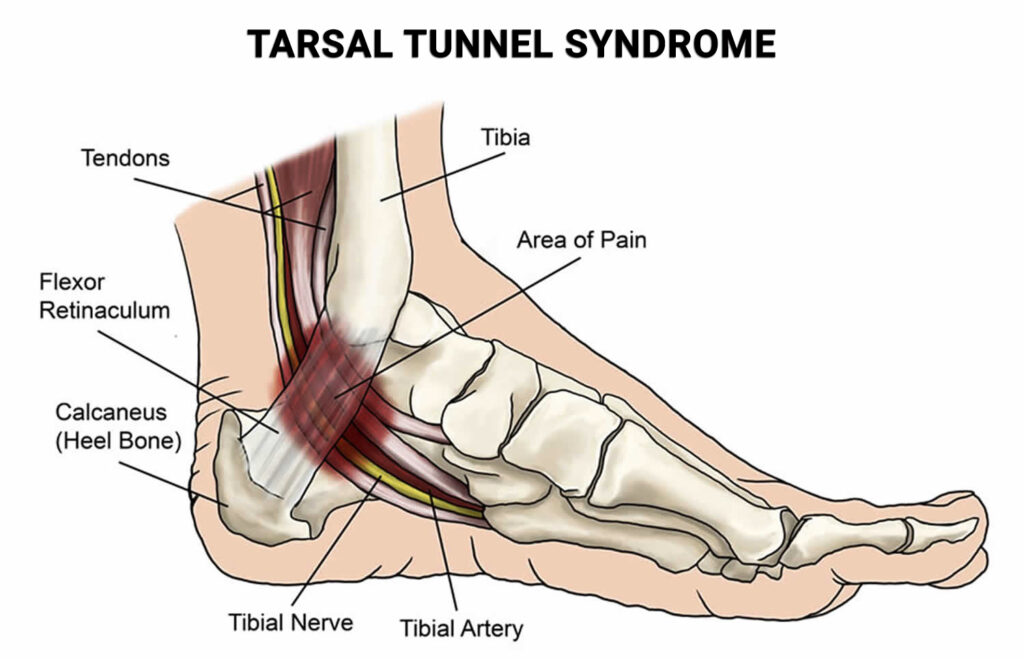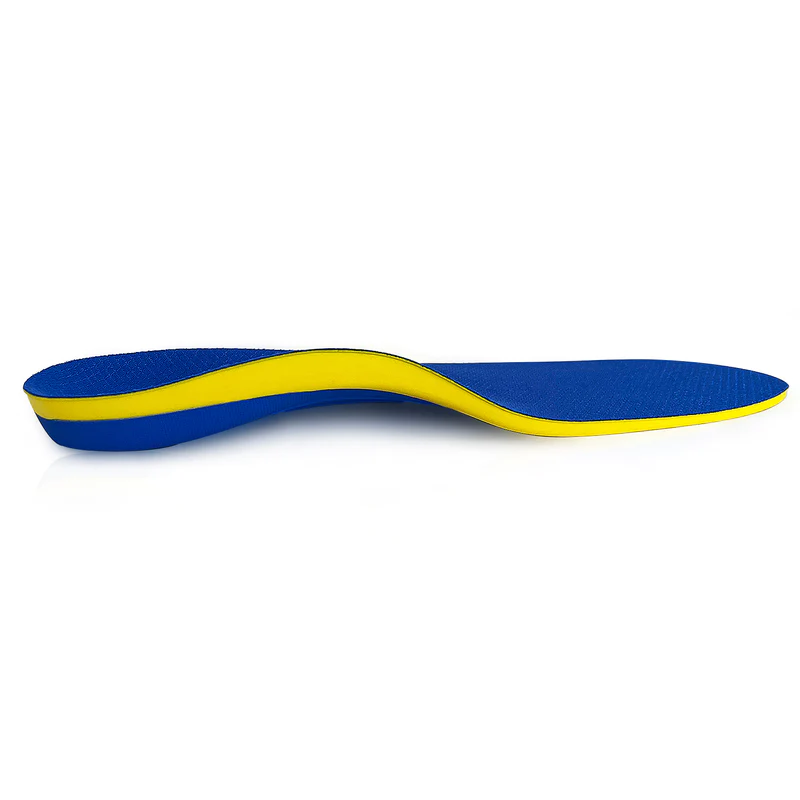Discover the ultimate guide to Tarsal Tunnel Syndrome (TTS), featuring innovative treatments, symptom management, and expert advice to navigate this challenging condition. Learn how to achieve lasting relief and improve your quality of life today.

Introduction
Tarsal Tunnel Syndrome (TTS) is a complex condition that affects many, causing discomfort and limiting mobility. This comprehensive guide delves into the causes, symptoms, and both conservative and advanced treatment options for TTS. Armed with expert insights and practical advice, you’ll be equipped to tackle TTS head-on, aiming for a pain-free and active lifestyle.
Table of Contents
What is Tarsal Tunnel Syndrome?
Tarsal Tunnel Syndrome (TTS) is a medical condition where the posterior tibial nerve experiences pressure as it travels through the tarsal tunnel on the ankle’s inner side. This area serves as a conduit for nerves, arteries, and tendons. Compression of the posterior tibial nerve can cause symptoms that affect the foot’s function and comfort.

Factors Contributing to Tarsal Tunnel Syndrome
Several elements can lead to the onset of Tarsal Tunnel Syndrome (TTS), including:
Anatomical Foot Differences: Unusual foot structures, like flat feet, may increase stress on the tarsal tunnel, causing nerve compression.
Injuries: Ankle injuries, such as sprains, can lead to swelling that compresses the nerve.
Systemic Diseases: Conditions like diabetes or arthritis can lead to swelling, impacting the nerve within the tarsal tunnel.
Repetitive Movements: Continuous foot activities can heighten pressure on the nerve.
Innate Foot Variations: Some people have natural anatomical foot differences that make them more susceptible to nerve compression.
Direct Trauma: Physical impact to the ankle can cause inflammation and swelling, leading to TTS.
Growths: Noncancerous tumors or cysts near the tarsal tunnel can press on the nerve.
Varicose Veins: The enlarged veins can exert pressure on the nerve within the tunnel.
Obesity: Increased body weight can put extra pressure on foot structures, including the tarsal tunnel.
Scar Tissue: Scar tissue from surgeries or injuries can alter the space within the tunnel, compressing the nerve.
Inflammatory Conditions: Diseases such as gout or tenosynovitis can cause swelling of the tissues in the tunnel, leading to nerve compression.
Understanding the Symptoms of Tarsal Tunnel Syndrome (TTS)
Early detection and prompt treatment of Tarsal Tunnel Syndrome (TTS) are essential. Here’s a closer look at the symptoms to aid in recognizing this condition:
Tingling or Numbness
Often described as a “pins and needles” feeling, this symptom can extend to the foot, ankle, or toes, indicating pressure on the posterior tibial nerve and disruption of normal sensory functions.
Pain
The pain experienced can vary from sharp, shooting sensations to a constant burning feeling, directly linked to the compression of the nerve within the tarsal tunnel and resulting in increased nerve sensitivity.
Weakness
Nerve compression may weaken neural signals to the muscles of the foot, diminishing muscle strength, affecting stability, and complicating daily activities.
Burning Sensations
A severe burning along the nerve’s path suggests significant irritation or damage, severely affecting life quality.
Electric Shock-like Pains
Sharp, sudden pains resembling electric shocks may occur spontaneously or in response to specific movements or pressure, indicating acute nerve distress.
Coldness in the Foot
A sensation of coldness in the foot, irrespective of actual environmental temperatures, can indicate impaired nerve function in temperature perception.
Weakness in the Foot Muscles
Difficulty with foot movements, such as lifting the heel, points to muscle weakness due to diminished motor signal transmission from the nerve.
Swelling
While not a direct symptom of TTS, swelling in the ankle or foot can aggravate tibial nerve compression, increasing discomfort and intensifying symptoms.
Altered Sole Sensations
Changes in how pressure and texture are felt, such as feeling as if walking on pebbles, reflect altered nerve function, leading to discomfort during walking or standing.
Pain that Worsens with Activity
Symptoms often intensify with physical activities that strain the tibial nerve, like walking or standing for long periods. Rest may offer temporary symptom relief.
Night-time Symptoms
Pain and discomfort may escalate at night, possibly due to the day’s cumulative strain on the nerve or changes in pain signal processing during rest.
Addressing Tarsal Tunnel Syndrome: Diagnosis and Treatment
Identifying Tarsal Tunnel Syndrome (TTS) accurately is essential for effective relief. Medical professionals employ various techniques to diagnose this condition:
| Physical Examination: In-depth inspection for signs of nerve compression and evaluation of foot structure. |
| Electromyography (EMG): A diagnostic tool that records the electrical activity of muscles, providing insight into nerve functionality. |
| Imaging Tests: MRI or ultrasound imaging helps visualize the tarsal tunnel region to spot structural irregularities. |
Strategies for Managing Tarsal Tunnel Syndrome
Managing TTS effectively requires a tailored strategy that targets both the symptoms and their underlying causes. Here are comprehensive approaches to TTS management:
Conservative Treatments

Rest and Elevation: Reducing activities that exacerbate symptoms and elevating the affected foot can help lessen swelling and pressure on the tarsal tunnel.
Ice Therapy: Applying ice packs can help reduce pain and inflammation. It’s important to wrap the ice to avoid direct skin contact.
Orthotic Devices and Supportive Footwear: Custom orthotics can provide essential arch support, redistributing pressure across the foot. Selecting supportive footwear is also crucial.
Medications: Nonsteroidal anti-inflammatory drugs (NSAIDs), such as ibuprofen, can help control pain and inflammation. Prescription medications may be considered for more intense pain.
Physical Therapy: Custom exercises can strengthen the muscles around the foot, improving mechanics. Techniques like ultrasound or electrical nerve stimulation may also be used to alleviate symptoms.
Advanced Treatments

Steroid Injections: Corticosteroid injections can offer temporary relief from inflammation and pain, although their effectiveness may wane, necessitating additional interventions.
Surgical Treatment: Surgery may be an option to decompress the tarsal tunnel ligament if conservative treatments are ineffective, aiming to alleviate nerve pressure. The success of surgery depends on individual factors.
Lifestyle Modifications and Home Remedies
| Weight Management |
| Maintaining a healthy weight can decrease stress on the foot, easing TTS symptoms. |
| Ergonomic Adjustments |
| Adjusting work and activity environments to reduce foot strain, and opting for low-impact exercises like swimming, can prevent symptom aggravation. |
| Arch Support |
| Arch Supports |
| Best Arch Support Insoles |
| Best Insole for Plantar Fasciitis |
| Insole for Flat Feet |
Frequently Asked Questions
Q: What is Tarsal Tunnel Syndrome (TTS)?
A: TTS is a condition where the posterior tibial nerve is compressed as it travels through the tarsal tunnel on the ankle’s inner side, leading to pain, numbness, and other discomforts in the foot.
Q: What causes Tarsal Tunnel Syndrome?
A: Causes include anatomical foot differences, injuries, systemic diseases, repetitive movements, direct trauma, growths, varicose veins, obesity, scar tissue, and inflammatory conditions.
Q: How is Tarsal Tunnel Syndrome diagnosed?
A: Diagnosis involves a physical examination, electromyography (EMG) to measure muscle electrical activity, and imaging tests like MRI or ultrasound to visualize the tarsal tunnel area.
Q: What are the treatment options for TTS?
A: Treatment ranges from conservative methods like rest, ice therapy, orthotics, and physical therapy to advanced options such as steroid injections and surgical intervention, depending on the severity.
Q: Can lifestyle modifications help manage TTS symptoms?
A: Yes, weight management, ergonomic adjustments, and activity modification can significantly reduce symptoms and improve foot health.
Conclusion
Navigating Tarsal Tunnel Syndrome requires a comprehensive approach, from understanding its causes to implementing effective treatment strategies. By staying informed and proactive, individuals can manage symptoms, enhance mobility, and reclaim their quality of life. Remember, early detection and treatment are key to successfully overcoming TTS. Embrace the journey towards recovery with confidence, supported by the insights and strategies outlined in this guide.



MOST COMMENTED
Animal-Based Proteins / Casein Protein / Dietary Protein / High-Protein Diets / Pea Protein / Plant-Based Proteins / Protein / Protein Deficiency / Protein Supplements / Proteins / Whey Protein / Whey Proteins
Is Protein Powder Safe for Teenagers and Children?
Animal-Based Proteins / Casein Protein / Dietary Protein / High-Protein Diets / Pea Protein / Plant-Based Proteins / Protein / Protein Deficiency / Protein Supplements / Proteins / Whey Protein / Whey Proteins
Unlock the Power of Proteins for Optimal Gut Health
Multivitamin
Total Health: Multivitamin for Active Lifestyles
Multivitamin
WellnessFusion: Complete Multivitamin Support
Dietary Supplement
Revitalize Your Health: The Magic of Red Yeast Rice Capsules
Foot care / Foot Health
Revitalize Your Foot Care Routine: Essential Tips for Optimal Foot Health
Foot Problem / Diabetics / Foot Health
Diabetics: Mastering Footwear Selection for Enhanced Foot Health and Ultimate Comfort
Exercises and Footwear Tips for Hammertoe Relief / Foot care / Foot Health / Foot Pain / Foot Problem / Hammertoes
Unlock Effective Exercises and Footwear Tips for Hammertoe Relief
Hammertoes / Foot Health / Foot Pain / Foot Problem
Unlock Relief: Essential Guide to Hammertoes Causes, Symptoms, and Treatments
Foot Problem / Foot Health
Revolutionize Your Recovery: Natural Remedies for Plantar Fasciitis – Fresh Home Keepers